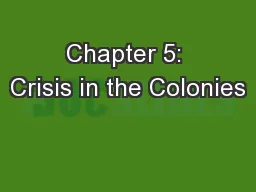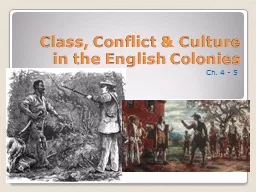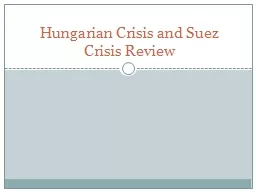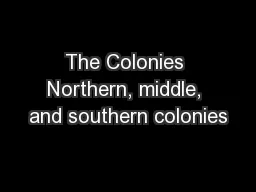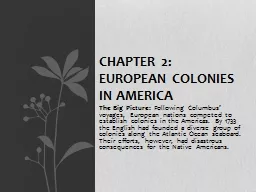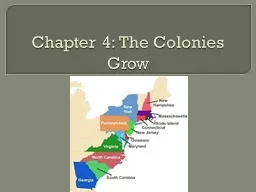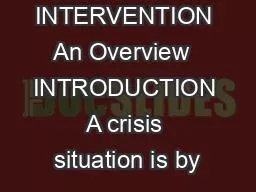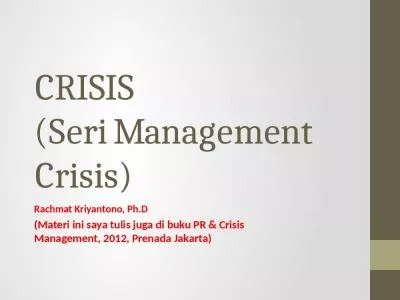PPT-Chapter 5: Crisis in the Colonies
Author : pasty-toler | Published Date : 2017-05-25
51 The French and Indian War Also known as the Seven Years War 17561763 France was the biggest rivalry to the English They built a system of forts blocking the
Presentation Embed Code
Download Presentation
Download Presentation The PPT/PDF document "Chapter 5: Crisis in the Colonies" is the property of its rightful owner. Permission is granted to download and print the materials on this website for personal, non-commercial use only, and to display it on your personal computer provided you do not modify the materials and that you retain all copyright notices contained in the materials. By downloading content from our website, you accept the terms of this agreement.
Chapter 5: Crisis in the Colonies: Transcript
51 The French and Indian War Also known as the Seven Years War 17561763 France was the biggest rivalry to the English They built a system of forts blocking the English to travel west Conflict in the Ohio Valley. And 57375en 57375ere Were None meets the standard for Range of Reading and Level of Text Complexity for grade 8 Its structure pacing and universal appeal make it an appropriate reading choice for reluctant readers 57375e book also o57373ers students Ch. 4 - 5. Conflict in the Colonies. Bacon’s Rebellion. Virginia 1676. Led by back country . planter. Nathaniel Bacon . House of Burgesses took away the right to vote from landless freemen & refused to protect them from Indian attacks. 1619-1700. Quick Reformation Story. Martin Luther creates 95 Theses in Wittenburg. List of problems with Catholic Church . Bible alone was the sole word of God and Faith- through salvation. Catholic/Protestants. Geography. Five colonies that make up the south are:. Maryland. Virginia. North Carolina. South Carolina. Georgia. Share a coastal area called the tidewater which was a flat lowland that includes many swampy areas. New England Colonies. 1. Massachusetts 1620. 2. Connecticut 1635. 3. Rhode Island 1636. 4. New Hampshire 1638 . Reasons settled. 1. Religious freedom. 2. Trade. Climate. Bitter cold winters. Short growing seasons. - Geography -. . NEW ENGLAND. MIDDLE. SOUTHERN. Geography. - Features that. make the region. unique. - Farthest north.. - Cooler Climate:. - Shorter growing. season.. - Helped prevent. In 1956, two concurrent events transformed the postwar pattern of international relations. The Suez crisis marked the end of innocence for the Western Alliance; henceforth, the . Western allies would never again be able fully to believe in their own avowals of a perfect symmetry of interests. Simultaneously, the bloody suppression of the Hungarian uprising showed that the Soviet Union would maintain its sphere of interest, by force if necessary, and that talk of liberation was empty. There could no longer be any doubt that the Cold War would be both protracted and bitter… Kissinger, Diplomacy, pp. 550-551.. Create your new colony. You have found a new colony-congratulations! Now you have some decisions to make:. Economy-How will you make $$?. Government-How will it be structured?. Social/cultural aspects-what are they? What is life like? Are there social classes?. Chapter 2: European Colonies in America. Main Idea: . In the 1500s and 1600s, European nations led by Spain, continued to explore, claim territory, and build settlements in America.. Chapter 2 Section 1: European Settlements in North America. Southern Colonies. 13 Colonies. New England-1620. New England Colonies. New England Colonies. Massachusetts Bay Colony. Rhode Island Colony. Connecticut Colony. New Hampshire Colony. Puritan. Town meeting. La gamme de thé MORPHEE vise toute générations recherchant le sommeil paisible tant désiré et non procuré par tout types de médicaments. Essentiellement composé de feuille de morphine, ce thé vous assurera d’un rétablissement digne d’un voyage sur . Section 1: Life in the Colonies. Colonial Immigration. Population, 1700: 250,000. Population, 1770s: 2.5 million . Slave population, 1700: 28,000. Slave population, 1770s: > 500,000. The population was well over 9,000. Definition and Types of Crises A crisis involves a disruption of an individuals normal or stable state More specifically a The Precipitating FactorThe precipitating factor is the event that converts a Rachmat Kriyantono, Ph.D. (Materi ini saya tulis juga di buku PR & Crisis Management, 2012, Prenada Jakarta). WHY IMPORTANT TO STUDY CRISIS. ....???. Every organization is likely to experience crisis.
Download Document
Here is the link to download the presentation.
"Chapter 5: Crisis in the Colonies"The content belongs to its owner. You may download and print it for personal use, without modification, and keep all copyright notices. By downloading, you agree to these terms.
Related Documents

